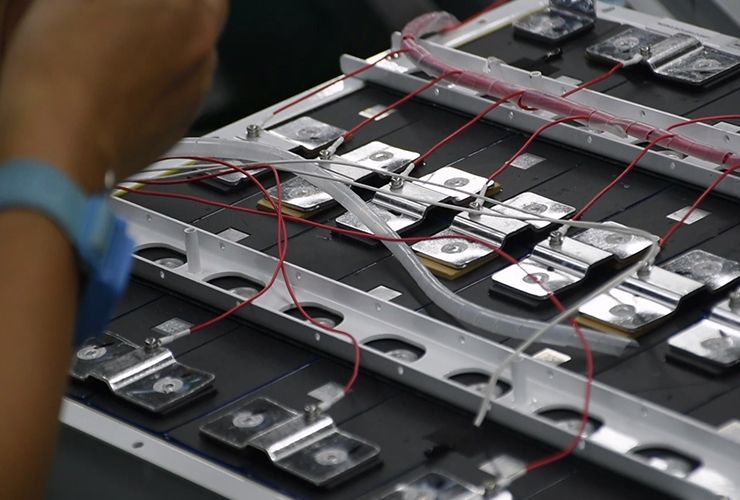Released on Oct. 17, 2023
This article aims to unravel the intricate workings of battery energy storage systems (BESS). As the demand for renewable energy integration and grid stability grows, BESS has emerged as a vital technology for storing excess electricity and ensuring a reliable power supply. By delving into the technical aspects of BESS operations, we can gain a comprehensive understanding of how these systems function and contribute to a sustainable energy future.
1.Battery Composition:
Battery energy storage systems primarily rely on lithium-ion battery technology due to its high energy density, efficiency, and long cycle life. These batteries consist of multiple cells, each comprising a positive electrode (cathode), a negative electrode (anode), and a separator. The electrodes, typically made of lithium compounds, facilitate the movement of lithium ions during charging and discharging cycles.
2.Charging Process:
The charging process begins when an external power source, such as renewable energy generators or the electrical grid, supplies electricity to the battery system. This electrical energy prompts a series of chemical reactions within the battery cells. During charging, the positively charged lithium ions migrate from the cathode to the anode, where they are stored within the battery's active materials. Simultaneously, electrons flow through an external circuit, providing a usable electrical current.
3.Discharging Process:
When the stored energy is needed, the discharging process occurs. Upon receiving a signal from the control system, the battery releases the stored electrical energy. This prompts the lithium ions to move from the anode back to the cathode, while the electrons flow through the external circuit, generating an electrical current that can be utilized for various applications.
4.Battery Management System (BMS):
A crucial component of a battery energy storage system is the Battery Management System (BMS). The BMS monitors and controls the charging and discharging processes, ensuring optimal performance, safety, and longevity of the battery. It regulates factors such as temperature, voltage, and current flow, preventing overcharging, over-discharging, and thermal runaway.
5.Power Conversion:
Battery energy storage systems also incorporate power conversion components to facilitate the integration with the electrical grid or other energy sources. These components, including inverters and converters, convert the direct current (DC) output from the battery into alternating current (AC), aligning with the grid's voltage and frequency requirements. This enables seamless energy transfer between the battery system and the grid, maximizing operational efficiency.

6.Grid Integration and Applications:
Battery energy storage systems offer various grid integration and application possibilities. They can smooth out fluctuations in renewable energy generation by absorbing excess energy during periods of high production and releasing it during times of low production. BESS can also provide grid stabilization services by responding rapidly to changes in electricity demand and frequency, ensuring a reliable and resilient power supply. Additionally, BESS can serve as backup power sources during grid outages, supporting critical loads and enhancing grid resiliency.
7.Energy Management and Control:
To optimize the performance of battery energy storage systems, sophisticated energy management and control systems are employed. These systems employ advanced algorithms and real-time data analysis to determine the most efficient charging and discharging strategies, considering factors such as electricity prices, grid conditions, and user preferences. This dynamic control enables BESS to adapt to changing energy dynamics and maximize the economic and operational benefits.
8.Safety Considerations:
Safety is of paramount importance in battery energy storage systems. Measures such as thermal management systems, protective enclosures, and robust monitoring systems are implemented to mitigate the risk of thermal runaway, overcharging, or other hazardous conditions. Stringent safety standards and regulations govern the design, installation, and operation of BESS to safeguard both the system and the surrounding environment.
Conclusion:
Battery energy storage systems provide a critical solution for storing excess electricity, enhancing grid stability, and supporting the integration of renewable energy sources. By understanding the underlying mechanisms of BESS, including the battery composition, charging and discharging processes, management systems, power conversion, and safety considerations, we can appreciate their role in enabling a sustainable and reliable energy future. As technology advances and costs decrease, battery energy storage systems are poised to play an increasingly vital role in the global energy transition.
Navigation
Mob: +86 186 6629 0033
Tel: +86 0769 85544410
Fax: +86 0769 85544410
E-mail: info05@zwaynenergy.com
WhatsApp: +86 137 1409 6556
Wechat: +86 186 6629 0033
Office: 16th Floor, Yunhua building, shajing Town, Shenzhen, PRC
Add: Room 101, Building 1, No. 18 Hu Nan Road, Changping Town, Dongguan City, Guangdong Province
Follow Us